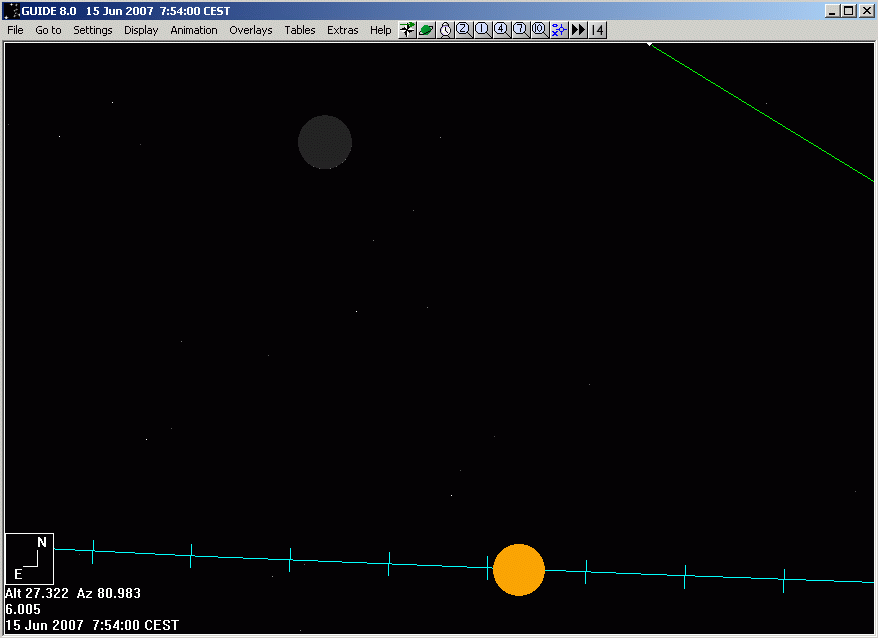
The constellation of sun and moon at 07:54 CEST.
www.mondatlas.de: Version of 19. May 2008
Martin Elsässer
The presented images won the lunar crescent imaging contest of the Interstellarum magazine. To the best of our knowledge this is the thinnest lunar crescent ever to be imaged from the ground.
New moon was on the morning of 15. June, at 05:13 CEST with quite a large angular distance of 3.6° edge-to-edge. The moon moved farther away from the sun during the rest of the day.

The constellation of sun and moon at 07:54 CEST.
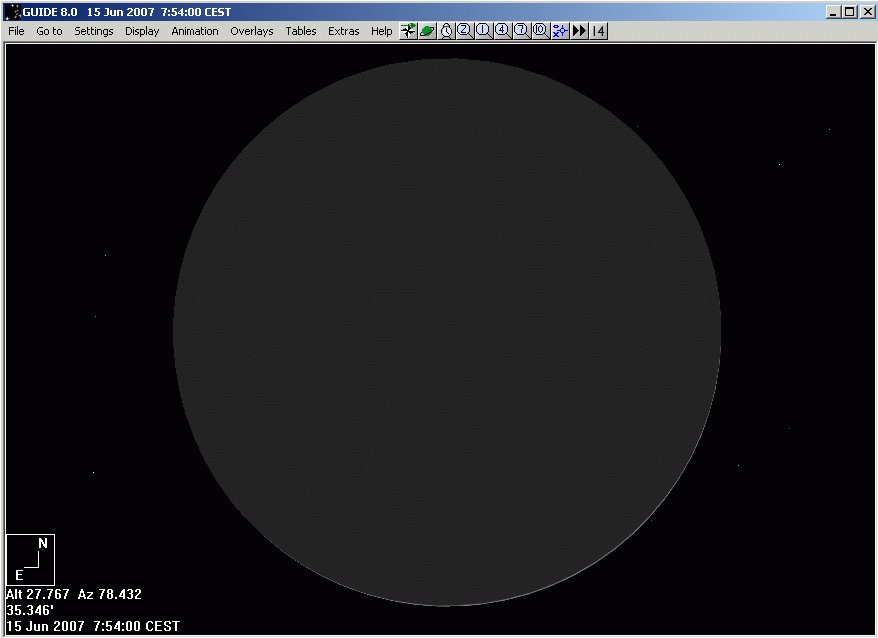
Shape and size of the crescent, as shown by Guide 8. The crescent appears extremely thin.
For observing this extreme crescent we left munich and drove to the Stuhleck, a 1800m mountain in the south-east of austria, escaping the clouds arriving from the north-west.
Sunrise from the Stuhleck, facing north-east towards distant vienna.
Sign of the Alois-Günther-Haus at the top of the Stuhleck mountain in Austria.
We set up our equipment right next to the building, so we could use the 230V power and also get some protection from the gusty wind.
The equipment next to the house: a 140mm refractor with a focal length of 800mm and a additional baffle in front of the scope. The mount was a MAM50, controlledby the well-known FS2.
The camera used was a Sigma 6303 with 9mu pixel size. The camera was oriented along the coordinate-lines, so north is up and west is to the right in all images. With the optics used a pixel has a size of 2.31 arcseconds at 1x1 binning.
The actual imaging was more difficult then expected. At first sun and moon had to rise above a layer of thin clouds, till the clear region of the sky was reached. From this point we continously captured series of images, with different settings of the camera.
We found a large number of traces of pollen and flying insects on the images and serious stray-light, indicating that the baffles used were not very effective.
From the west banks of clouds approached and ended the imaging at 11:30 CEST. When we left 90minutes later we caught the first raindrops, so we hit the weather quite perfectly.
Processing the images was quite difficult as serious stray light and a large number of insect-traces were captured, together with other strange artifcats.
We later found it most effective to process all images identically and play them in rapid sequence, to find the extremely faint crescent in the noise. With this approach the crescent could be found as a thin sliver in a series of images only 2.7 hours after (geocentric) new moon, at an elongation of 4.75 degrees. This elongation is far smaller then the well known Danjon limit, which states that no crescents can be seen at elongations below 7.5 degrees.
The images of the individual series could be stacked through specially written software, despite the crescent not being visible in the individual images. For this task the drift was mathematically modelled and this model was used for aligning the images.
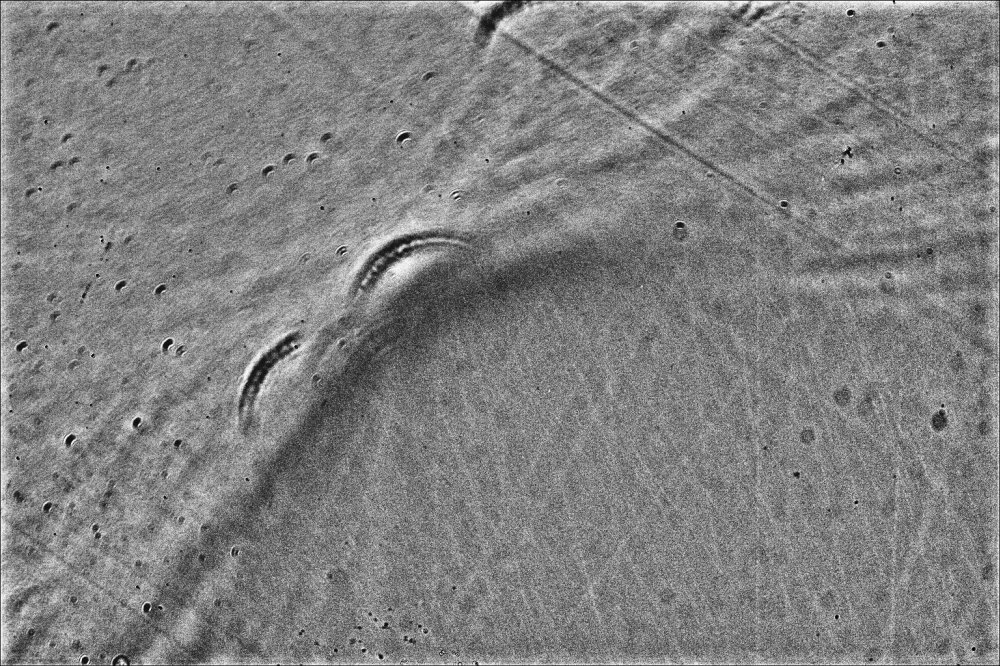
A typical pre-processed image, shrunk to 67%. A auto-flat has been applied to remove the large variations in brightness. We have dust-shadows, traces of insects, artifacts of the camera-shutter, brightness variations in the sky and strange effects of the badly designed baffles. BUT, there is also the very thing crescent visible, to the right and below the strange coke-bottle-imprint in the center.
A Video of the 4h lunar crescent (5MB!) from the images of a series where the crescent can be seen, 4hours after new moon.
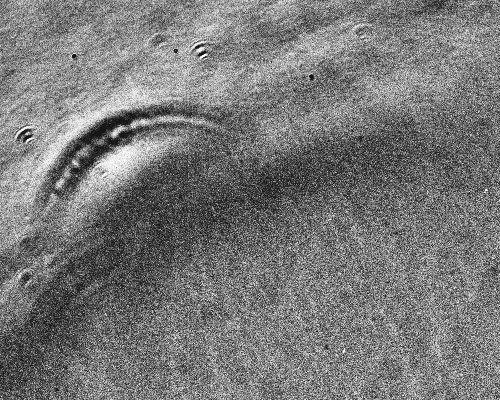
A crop of a single image in full-size, where the crescent can be seen, in the center of the image. The image was taken at 09:10 CEST, less then 4 hours after new moon.
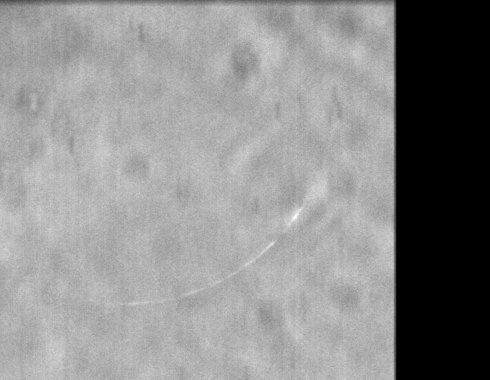
Sum of 51 images taken between 10:07 and 10:24 CEST, 5h after new moon. The raw images were processed with auto-flats and stacked with the special software.
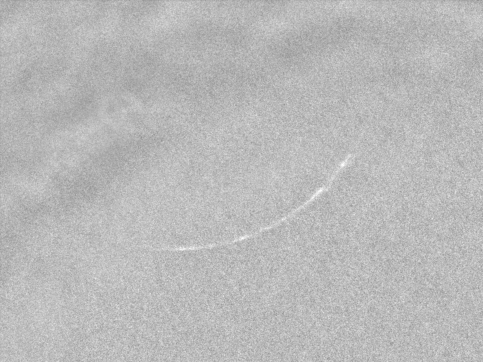
Sum of 84 images from the fifth series, which starts less than 4hours after new moon. The middle of the series is at 09:24 CEST, 4hours 11minutes after new moon.
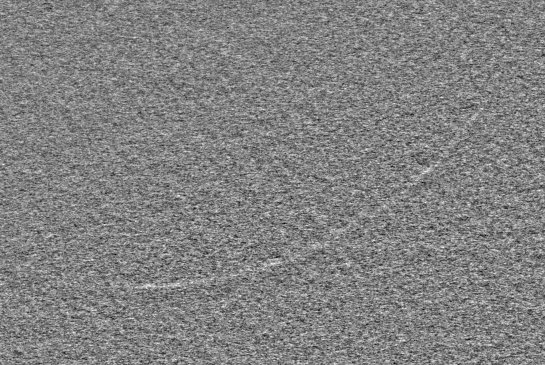
Sum of 14 images from the forth series, taken between 08:34 and 08:45 CEST in 1x1 binning. The middle of the series is 3 hours 27 minutes after new moon. The elongation was 5.0°.
The Video of the 3.5h lunar crescent (3MB!) from the images of this series.
The images were processed by first applying a flat generated from the average of all images and then applying a auto-flat. This approach removed most of the static artifacts.
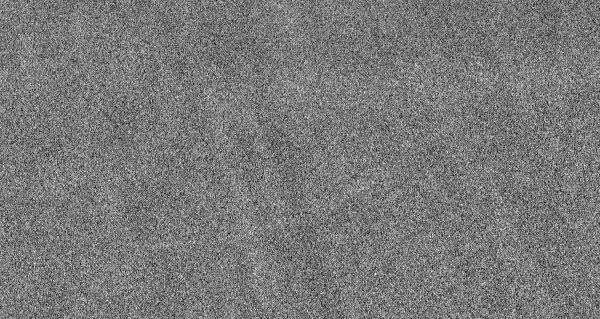
Sum of the last 21 images of the third series, taken around 07:54 CEST, which is 2hours 41 minutes after (geocentric) new moon. The elongation of the moon is 4.75 degrees, which is far smaller then the Danjon-limit.
This image won the lunar crescent imaging contest by a wide margin.
The Video of the 2.7 hour lunar crescent (5MB!) from the last 21 images. The crescent can be found as thin line in the middle, drifting slowly to the upper-left.
How 2 capture extreme lunar crescent images
Processing of lunar crescent images